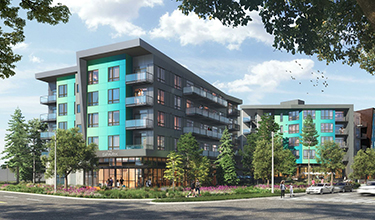|
Subscribe / Renew |
|
|
Contact Us |
|
| ► Subscribe to our Free Weekly Newsletter | |
| home | Welcome, sign in or click here to subscribe. | login |
Architecture & Engineering
| |
 |
March 30, 2023
Natural direction is a new path in architecture
Tiscareno Associates

Kinsch
|
It’s a foundational rule of architecture: design buildings that work within their surroundings. More and more, this requires us to incorporate natural elements. In cities where density is dialing up, we’re increasingly adding natural counterpoints (roof gardens, woonerfs) to breathe fresh air into projects. Conversely, where mass transit is making wilderness-adjacent suburbs more accessible, a project’s existing natural surroundings need to be thoughtfully integrated into the design.
At Tiscareno Associates, a Seattle architecture firm specializing in mixed-use and TOD, we are seeing this phenomenon vividly play out at the Spark, a five-story, 224-unit mixed-use apartment development near the coming light rail station in suburban Redmond.
There, owner MainStreet Property Group prioritized eclectic design, community connection, and sustainability — values we share and are always gratified to encounter. But the transitional industrial-park environment around the site offered no context or sense of place for inspiration. The city of Redmond’s generous open-space requirements added another layer of challenge.
An existing parking strip filled with mature trees and proximity to Marymoor Park sparked inspiration. “What if we create an urban forest?” the president of MainStreet Property Group mused one day. We already knew that the long site would require us to break the project into smaller masses to establish a more pedestrian scale. Creating two buildings — now called the Gateway and the Avenue — would allow us to run public open space right through the middle of the project, bringing to the suburbs an urban level of pedestrian focus and letting the openness and greenery of nature both fulfill open-space requirements and dial up quality-of-life for residents.
We made this urban forest the Spark’s signature, designing a landscape with densely planted trees flowing into the street frontage and directing pedestrians toward the nearby community center and Marymoor Park. So integral is the urban forest to the project’s overall design, the design review board asked the landscape architect to show the trees’ maturity levels at installation, five years out, and 10 years out. To mimic the natural forest, the plan includes a planted understory along with trees of varying ages, allowing the forest to look mature while the trees thrive and grow at their own pace.
Within the trees, our landscape architect Site Workshop added three outdoor areas that invite gathering. The Clearing provides varied open spaces with safe, comfortable sightlines for people to sit or meet for yoga. The Ring is a central open space in the trees between the Gateway and Avenue buildings with a fire pit and stepped seating. It creates a gathering area and softens the grade transition between the buildings. From each building, exterior stairs enable residents to emerge from the buildings into this treed landscape, while overhead a second-story pedestrian bridge links the buildings, allowing users bird’s-eye-view connections with the forest.
This degree of focused attention on outdoor built environments is not new. Biophilic design emerged in the latter decades of the 20th century as an approach to architecture that seeks to connect building occupants more closely to nature, through the creation of habitats that contribute to human health and productivity. At least a decade’s worth of data reveals that natural connections measurably enhance human productivity, creativity, and wellbeing. Indeed, the third area in the forest, the Scramble, consists of a series of interactive natural elements — like boulders that can be climbed — to bring users closer to their environment. A water runnel, oversized stepping stones, and small seating nooks show up here.
What is new, however, is the increased emphasis on outdoor environments that the pandemic brought. At Tiscareno we are learning that projects which want to meaningfully promote community must include outdoor gathering areas. In addition to the Spark’s wooded clearings, we sought to build ground-level programming that creates intentional transitions from inside to outside. Along the Avenue Building, we designed a raised “front porch” called the Forest Dock to front the Spark’s ground floor restaurant/retail spaces: a long, deep deck to provide the outdoor seating the whole world learned to value over the last three years. The Gateway’s ground floor spaces open out to patio seating adjacent to the urban forest.
For a project so integrated with nature, it followed naturally that building aesthetics should also convey the message. To gently echo the landscape, we designed a roofline on the Gateway building that rises and falls in harmony with the roof on the Avenue building, creating a continuation of line across the urban forest that subtly evokes hills on a horizon. We used metal mirror-finished panels between the buildings that reflect and expand the urban forest. Prismatic metal cladding on each building changes its appearance depending on weather, time of day, position of viewer, and more: a responsiveness to the natural world that enables the building to mimic nature itself.
Of course, no amount of integration with nature means a thing if a building isn’t built sustainably, so efficient systems and carbon offsets will enable the Spark to achieve LEED Platinum, net-zero energy, and Fitwel (a standard for the human experience of health and wellbeing) certifications. Solar panels will line the roof. As a transit-oriented development, the Spark will feature more than usual bike storage, fewer than usual car parking spaces, and an orientation that creates natural walking routes from the buildings to the light rail station.
As density packs urban cores and mass transit extends the city’s reach to more communities, nature will exert itself more and more in our built environments. This integration of built and natural environments is a growing edge within our firm and within our industry, but we have little doubt that in time, developments like the Spark will become a new normal.
Michelle Kinsch is a principal at Tiscareno Associates.
Other Stories:
- So you want to be a rock star (marketer)
- Engineering gets specialized in response to increasing complexity
- Equitable development: nice to have or essential best practice?
- At Glover Middle School, the lighting runs through it
- Engineering solutions, as waters rise
- Revitalizing downtowns with office-to-residential conversion
- Structures and sustainability: pursuing net-zero carbon emissions
- Employee ownership for all: an alternative to the ESOP
- New form of team work needed for multifamily projects
- In Edmonds, a park runs through it



